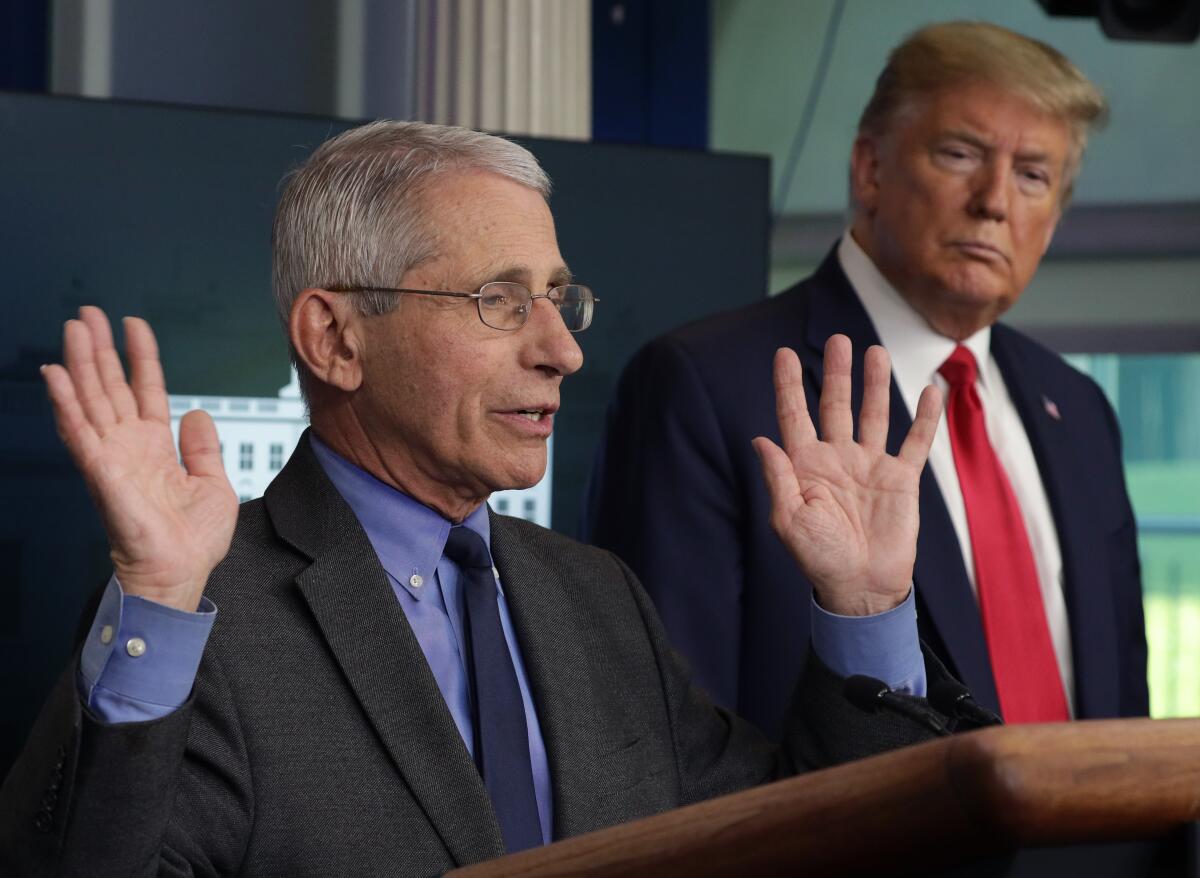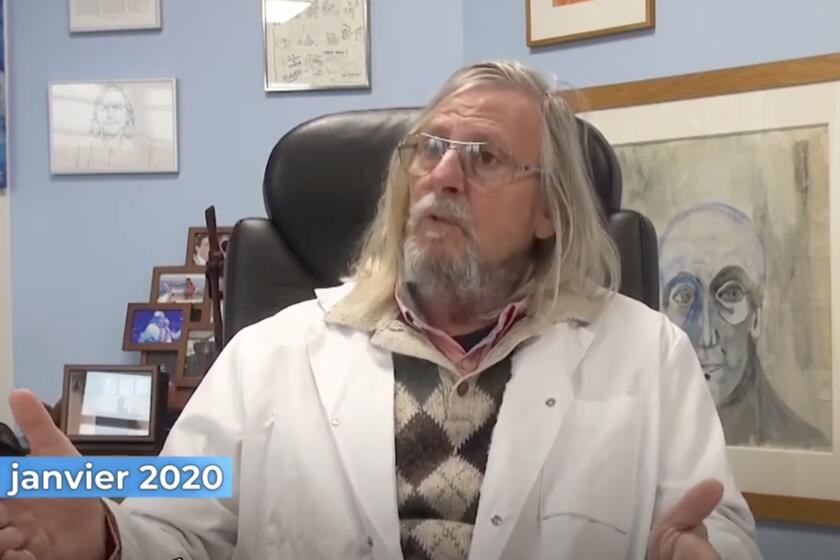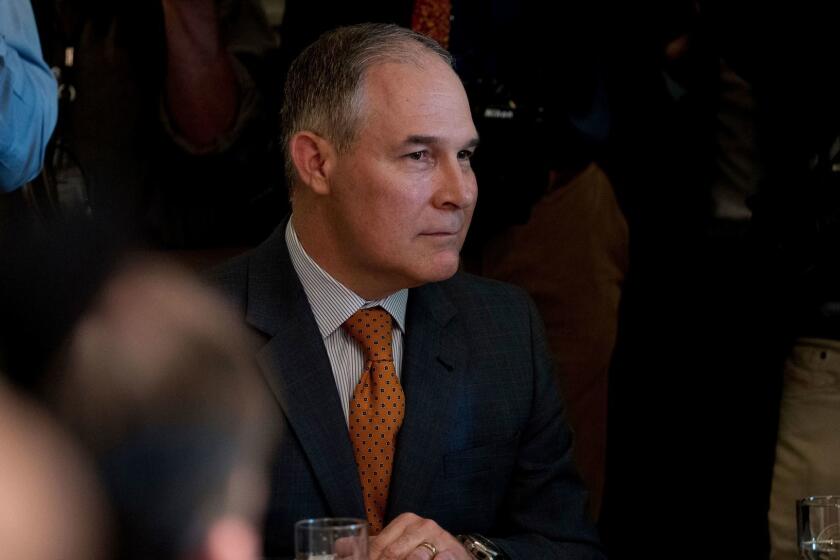Column: With attack on NIH, Trump steps up his assault on coronavirus science

Buried as it was within the usual blather, bluster and bunkum of President Trump’s daily coronoavirus briefings, Trump’s attack over the weekend on the National Institutes of Health went largely unnoticed.
But it’s dangerous to ignore it.
Trump’s comment about the NIH, which is the government’s largest purveyor of basic scientific research, came about 44 minutes into his hour-and-10-minute appearance Saturday. It was nestled next to his attack on the World Health Organization, the federal funding for which he says he is blocking.
Homes are full of sons, daughters, parents and siblings alive today because of breakthroughs uncovered through NIH-funded research.
— American Society for Biochemistry and Molecular Biology
Here’s what he said about the NIH:
“NIH is giving away a lot of money. A lot of money. We give away, for years, for many years, they give away a lot of money. And some people complain, and some people don’t. Some people are extremely happy, so we’re looking into that also. They’re giving away approximately, as I understand it recently, more than $32 billion a year, 32 billion. And so we’ve been looking at that for a while, and we’re going to be having some statements to be made about that. $32 billion a year. It’s a lot of money, and we want to make sure it’s being spent wisely.”
Trump’s expressions of distaste for the NIH go back years. During his presidential campaign in 2015, right-wing radio host Michael Savage asked him “to consider appointing me to head of the NIH ... because I know the corruption. I know how to clean it up, and I know how to make real research work again.”
Trump responded, “I think that’s great...because I hear so much about the NIH, and it’s terrible.”
It’s impossible to know whether Trump was telling the truth or was just feeding Savage applesauce, or if he even knew at the time what the NIH was. But he certainly wasn’t showing respect for the nation’s leading science agency.
The NIH declined to comment on Trump’s statements, though it referred me to its public digest of research activities.
President Trump’s hype of a potential treatment for COVID-19 gives false hope to virus patients and causes real harm to others.
The NIH did get support from the American Society for Biochemistry and Molecular Biology, which called the agency “the global gold standard for medical research and ... an honest and respectful steward of the American taxpayers’ funds. The record of Nobel Prize winners is full of NIH-funded researchers. Journals are full of research findings published by NIH-funded investigators. And homes are full of sons, daughters, parents and siblings alive today because of breakthroughs uncovered through NIH-funded research.”
What Trump knows today about the NIH is hard to glean. He may be aware that among its 27 institutes and other divisions is the National Institute of Allergy and Infectious Diseases, which happens to be headed by Dr. Anthony S. Fauci, currently the nation’s most respected source on coronavirus science and one of the few federal officials willing to contradict Trump in person.
But it’s unclear whether Trump knows that the NIH is also the chief government source for research funding in the war against the opioid epidemic and HIV. He may be somewhat more aware of its role in the coronavirus crisis because Fauci’s institute received an emergency infusion of $439 million to advance its work on the pandemic.
To paraphrase the ancient Greek poet Archilochus, Trump seems to know one big thing about the NIH: its budget. Naturally, he gets it not quite right.
The NIH budget for the current fiscal year is $41.7 billion, of which 80% is designated for outside grants. That’s money that could be reasonably defined as money it’s “giving away,” but it comes to more than $33 billion. In Trumpian math, one supposes, that’s close enough to rank as a direct hit.
Few federal agencies would entirely escape the meat cleaver in President Trump’s proposed budget, but none is facing more devastating cuts than the Environmental Protection Agency.
Beyond that, what is Trump talking about? What does he mean by “some people complain, and some people don’t,” and “some people are extremely happy.” What does he mean by “looking into that” or “looking at that”?
If he means he’s investigating whether the NIH is properly rigorous and reasonable about how it makes grants, where’s the evidence that it’s been irresponsible? For that matter, where’s the evidence that anyone in Trump’s circle actually is investigating the NIH, other than his unreliable say-so?
So one must look elsewhere for an explanation of what appears to be a fact-free, ungrounded slam of the National Institutes of Health. The best place to start is with the Trump White House’s three-year assault on government scientific research.
Examples of Trump’s hostility to hard science are almost too numerous to count. He staffed the Department of Health and Human Services with promoters of ideological nonsense about contraceptives. He blocked the distribution of scientific research by the Department of Agriculture.
Trump fostered a “monumental disaster” for science at the Interior Department, as the Union of Concerned Scientists documented, turning the agency in only two years from a steward of public lands and natural resources into a front for the mining and oil and gas industries. He tried to take a budgetary hatchet to the Environmental Protection Agency.
Trump’s proposal to roll back auto emission standards set by the Obama administration and to revoke the waiver allowing California to set its own was supported by scientific documentation so slipshod that it may fail in court.
Contraception policy may not be the biggest target of the anti-science right wing — climate change and evolution probably rank higher — but it’s the field in which scientific disinformation has the most immediate consequences for public health.
Just to bring matters up to date, there are Trump’s efforts to minimize the severity of the novel coronavirus pandemic and his promotion of unproven -- and so far unwarranted -- antivirus claims made for the antimalaria treatments chloroquine and hydroxychloroquine. Trump’s trump card, so to speak, to counter the dearth of solid scientific grounds for prescribing these potentially dangerous drugs was “I feel good about it. That’s all it is, just a feeling.”
These cases are part and parcel of what science writer Chris Mooney has termed “The Republican War on Science,” the title of a book he published in 2005, focusing on the policies of the George W. Bush administration.
As Mooney reported, Bush accounted for the lack of preparedness for the devastation foisted on New Orleans by Hurricane Katrina that year by claiming, “I don’t think anybody anticipated the breach of the levees” protecting the city from Mississippi River flooding.
That not only was demonstrably untrue, it bears a spooky resemblance to Trump’s claim that the spread of the coronavirus pandemic was unpredictable; in fact, high-level warnings reached the Trump White House weeks, if not months, before Trump started seriously to take action.
Here’s what a hospital chain went through to get a supply of coronavirus masks
Along with the National Science Foundation, the NIH has been one of the chief scientific targets of reactionary GOP legislators in Congress. As we’ve reported, the main goal of the Republican attack on government scientific agencies has been to undermine climate change research, which tends to undermine the economic goals of Republican patrons in the fossil fuels industry.
But the attack has long been part of a generalized attack on research funding. Often, the technique has been to paint research topics in apparently absurd terms by cherry-picking and caricature -- portraying a $227,000 project at Michigan State Unversity to examine the evolution of humans’ understanding of animal behavior as paying a researcher “to thumb through the pages of old National Geographic magazines to look at animal pictures.”
That was the method of former Rep. Lamar Smith (R-Texas), a leading climate change denier. But sadly it had bipartisan roots, as the pioneer of such philistine bloviating was Sen. William Proxmire (D-Wis.), who started issuing his “Golden Fleece” awards in 1975.
Proxmire liked to paint his antiscience philistinism as a campaign to protect taxpayers from wasteful government spending. That’s the burden of Trump’s remark that “we want to make sure [the NIH budget is] being spent wisely.”
The truth is that Trump has been trying virtually from the beginning of his term to cut funding for the NIH and other science agencies. In 2018, he proposed slashing the NIH budget for 2018-19 by 22%, to $26.9 billion from $34.6 billion. For the 2019-20 fiscal year, Trump again proposed cutting the NIH budget, this time by $5 billion, to $34.4 billion. And for 2020-21, he has proposed another $3-billion cut, to $38.7 billion from $41.7 billion.
In each year, Congress has ignored Trump’s request and increased the NIH budget instead. On Capitol Hill, then, at least some people are aware of the critical role America’s scientific infrastructure plays in public health -- now more than ever. If Trump knows, he isn’t showing it.
More to Read
Inside the business of entertainment
The Wide Shot brings you news, analysis and insights on everything from streaming wars to production — and what it all means for the future.
You may occasionally receive promotional content from the Los Angeles Times.













